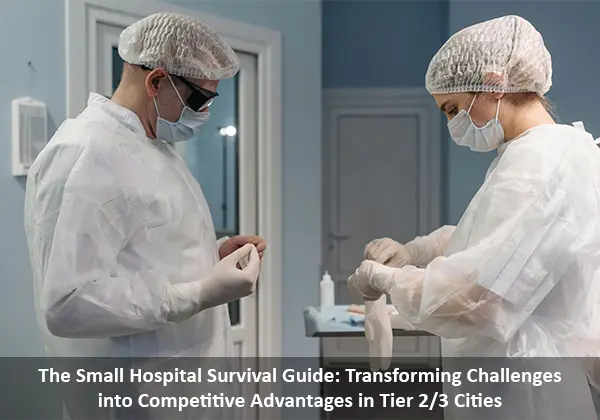Small hospitals with fewer than 50 beds serve as the healthcare lifeline for millions of people in India’s Tier 2 and Tier 3 cities. Typically run by individual practitioners or small groups, these hospitals face unique challenges that larger institutions rarely encounter. Yet within these challenges lie significant opportunities for those equipped with the right cost intelligence and strategic approach.
For small hospital owners and administrators, understanding and addressing these interconnected challenges isn’t just about survival—it’s about building sustainable, profitable healthcare enterprises that serve their communities effectively while achieving financial success.
The Five Critical Challenges Facing Small Hospitals
-
Infrastructure Limitations: Maximizing Basic Capabilities
Small hospitals typically operate with basic diagnostic and surgical capabilities, often lacking the advanced equipment found in larger institutions. This limitation affects the range of services offered and can impact patient confidence, leading to referrals to larger hospitals for procedures that could potentially be handled locally.
The Strategic Impact: Limited infrastructure constrains revenue opportunities while patients seek care elsewhere, reducing the hospital’s role in the local healthcare ecosystem and limiting growth potential.
-
Low Patient Footfall: The Visibility Challenge
Unlike large hospitals with established reputations, small hospitals struggle with limited visibility and marketing reach in their communities. Many residents may not even be aware of the services available locally, leading to unnecessary travel to distant cities for routine care.
The Consequence: Low patient volumes create a vicious cycle where fixed costs remain constant while revenue suffers, making it difficult to invest in improvements or market the hospital effectively.
-
Staffing Shortages: The Specialist Attraction Dilemma
Small hospitals face significant difficulty attracting specialists to smaller towns where lifestyle amenities, professional development opportunities, and peer networks may be limited compared to metropolitan areas. This shortage often forces hospitals to rely on visiting consultants or general practitioners for specialized care.
The Result: Inconsistent specialist availability limits service offerings, reduces patient confidence, and creates dependency on external consultants who may not be fully invested in the hospital’s long-term success.
-
Financial Fragility: The High-Risk Operating Environment
Small hospitals often operate with high debt levels and razor-thin margins, making them vulnerable to any disruption in patient flow, unexpected expenses, or economic downturns. Limited financial reserves mean that even minor operational challenges can threaten viability.
The Challenge: Without adequate financial cushions, hospitals struggle to invest in growth opportunities, upgrade equipment, or weather temporary setbacks that larger institutions could easily absorb.
-
Lack of Standardization: The Quality Perception Problem
Many small hospitals lack standardized clinical protocols, documentation systems, and quality management processes. This inconsistency can affect patient outcomes, create regulatory compliance issues, and damage the hospital’s reputation in the community.
The Impact: Without standardization, hospitals struggle to demonstrate quality care, achieve accreditation, or build the trust necessary for sustainable growth in competitive healthcare markets.
The Interconnected Nature of Small Hospital Challenges
These challenges don’t exist in isolation—they create a complex web of interdependencies. Infrastructure limitations reduce service offerings, which decreases patient footfall. Low patient volumes make it difficult to attract specialists or invest in infrastructure improvements. Financial constraints limit marketing efforts and standardization initiatives. Without proper cost intelligence, small hospitals often make decisions that inadvertently perpetuate these cycles.
How Proactive Solutech’s TDABC Transforms Small Hospitals
Proactive Solutech’s Time-Driven Activity-Based Costing (TDABC) solutions empower small hospitals in India’s Tier 2 and Tier 3 cities to boost efficiency, profitability, and growth within resource constraints.
TDABC Advantage
TDABC provides clear insights into resource utilization, revealing cost-saving and revenue-enhancing opportunities critical for small hospitals with tight margins.
Our TDABC Solutions
- Infrastructure Optimization: Identifies underused equipment and services to maximize returns without new investments.
- Patient Flow Optimization: Tracks patient journeys to reduce bottlenecks, improve efficiency, and enhance patient satisfaction.
- Service Line Profitability: Pinpoints high-return services and resource drains to guide strategic decisions.
- Staff Productivity: Optimizes staff time, reduces reliance on costly consultants, and improves retention within budgets.
- Operational Standardization: Implements cost-effective protocols for consistent quality.
- Financial Monitoring: Real-time cost tracking for proactive financial management.
- Growth Strategy: Identifies sustainable growth paths based on cost and market analysis.
- Regulatory Compliance: Ensures cost-effective compliance to meet standards and build trust.
Proven Results
- Cost Visibility: 25-35% better understanding of cost drivers.
- Efficiency: 15-25% improvement in resource use and patient throughput.
- Revenue: 10-20% revenue increase via optimized services and pricing.
- Stability: Improved cash flow and margins.
- Growth: Clear strategies for sustainable expansion.
Why Choose Us?
- Small Hospital Focus: Tailored solutions for resource-limited settings.
- Tier 2/3 Expertise: Designed for local market and regulatory conditions.
- Affordable & Scalable: Flexible models that grow with your hospital.
- Community Impact: Strengthens your role as a vital healthcare provider.
Transform your hospital with TDABC. Contact Proactive Solutech to optimize operations, boost profitability, and grow sustainably.
